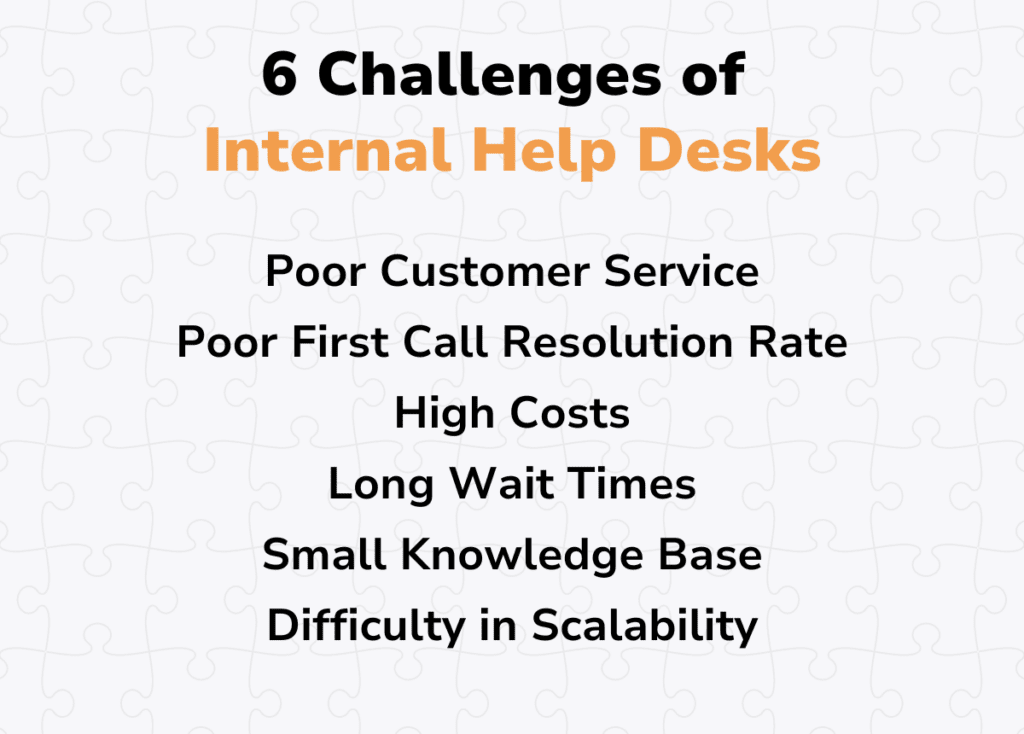It’s common for companies to believe they’re best equipped to support their customers due to their product knowledge, leading them to set up internal help desks. Although it seems reasonable to assume that knowledgeable and patient staff can provide good service, many internal help desks still fail to meet expectations. Why is this the case?
While working with the internal help desk teams at many companies, we’ve been able to identify several common factors that keep those teams from performing at a high level — and the blame rarely rests with the team members themselves. We’ll review six of the most common sources of problems.
6 Challenges Internal Help Desks Face:
- Poor Customer Service
- Poor First Call Resolution Rate
- High Costs
- Long Wait Times
- Small Knowledge Base
- Difficulty in Scalability
Effective support systems are crucial for maintaining high levels of customer satisfaction and operational efficiency. However, internal help desks often encounter systemic issues that can undermine their effectiveness. Here, we explore six critical reasons why internal help desks may not meet expectations, detailing the most significant financial and emotional costs.

1. Poor Customer Service
Internal help desks that lack effective customer service skills can lead to significant negative consequences. Prolonged call times not only reduce the efficiency of the help desk, leading to Increased Operational Costs, but they also significantly drain the company’s resources, reducing the time available to assist others and increasing overall expenses. This inefficiency results in Dissatisfaction among both employees and customers, who experience heightened frustration and disappointment due to the perceived neglect and poor service quality.
Inadequate customer service at help desks can lead to several negative outcomes:
- Increased Operational Costs: Longer calls consume more resources, reducing the time available for assisting other customers.
- Dissatisfaction: Employees and customers experience frustration due to poor conflict resolution and service delays.
- Emotional Toll: Disappointment and loss of patience become prevalent as service expectations are not met.
- Financial Strain: Every minute spent on unresolved issues drains the company’s budget further, exacerbating financial pressures.
It’s possible to get Amazon quality customer service on a small budget, see how in the linked article for a master class in Customer Service.
The next strategic piece for improving customer service outlines innovative approaches and key principles, emphasizing proactive engagement, personalized experiences, and continual improvement. Go beyond the basics and explore our insights into creating extraordinary customer service by asking two simple questions.
2. Poor First Call Resolution Rate
A low first call resolution (FCR) rate indicates that customer issues are not being resolved during the initial contact, leading to repeated calls and increased frustration. This inefficiency can cause significant disruptions, especially in environments like retail where IT issues can halt operations, resulting in Operational Disruption. Furthermore, the inability to resolve issues promptly leads to Customer Dissatisfaction, as extended wait times and unresolved problems erode trust and satisfaction, negatively impacting the company’s reputation.
A low first call resolution rate signifies inefficiency, with far-reaching implications:
- Operational Disruption: Unresolved IT issues can halt critical processes, especially in retail environments, leading to operational paralysis.
- Customer Dissatisfaction: Extended wait times and unresolved issues lead to unhappy customers, damaging the company’s reputation.
- Stress and Frustration: Both customers and staff feel the stress of lost time and the anxiety of unresolved issues, compounding frustrations across the board.
If you are ready to take the next step in improving your First Call Resolution Rate, take a look at the piece below to get started in your FCR Journey.
3. High Costs
Operating an internal help desk can be surprisingly expensive, particularly when considering the costs of training and continuous operation. Training Expenses are often substantial, with each employee requiring significant investment to become proficient. The costs associated with scaling to a 24/7 operation can be particularly prohibitive, leading to Scaling Costs that may make such a move unfeasible for many organizations. These expenses contribute to financial stress and limit the ability of the help desk to operate effectively and efficiently.
The financial implications of running an internal help desk are significant:
- Training Expenses: The cost of training full-time employees can be substantial, often running into thousands of dollars per employee.
- Continuous Monitoring and Downtime Costs: Ongoing supervision and the costs associated with downtime further strain budgets.
- Scaling Costs: Implementing a 24/7/365 help desk operation could add enormously to annual expenses.
- Emotional Impact: Financial pressures lead to stress and annoyance, impacting staff morale and customer perceptions.
To balance cost and quality, you first have to understand how onshore outsourcing can be a cost-effective solution for enhancing customer service, highlighting how it reduces operational inefficiencies and aligns with budgetary constraints while maintaining high service quality.
4. Long Wait Times
Inefficient call management and poor operational structures can lead to long wait times, which are among the most visible and frustrating aspects of poor help desk performance. Customer Impatience grows as wait times increase, leading to a perception of neglect and a lack of respect for customer time. Additionally, Revenue Loss becomes a serious concern as prolonged waits can lead to dropped calls and lost sales opportunities, directly impacting the company’s bottom line.
Extended wait times can severely impact customer service quality and satisfaction:
- Customer Impatience: Prolonged waits foster a sense of neglect and frustration among customers.
- Business Image: High abandonment rates from dropped calls can tarnish a company’s reputation as responsive and customer-focused.
- Revenue Loss: Every lost call or delayed service potentially translates to lost sales.
- Emotional Response: The annoyance and embarrassment caused by long waits can lead to a tangible sense of urgency and a reevaluation of business operations.
We know waiting sucks, no reasons to justify it. For a quick fix, check out how Queue Call Back makes waiting a thing of the past.
5. Small Knowledge Base
A help desk with a limited knowledge base struggles to resolve issues effectively, which can lead to frequent revisits to the same unresolved problems. This not only leads to ineffective problem resolution, which increases the likelihood of recurring issues, but also results in Increased Costs and Effort, as more resources are wasted on temporary fixes rather than sustainable solutions. This cycle of inefficiency udermines customer trust and leads to Customer Frustration, as the same issues continue to plague their experience. Knowledge management is the heart of customer service.
A limited knowledge base hampers effective problem resolution:
- Ineffective Resolutions: Issues may be temporarily fixed but often recur, necessitating further attention.
- Increased Costs and Effort: A smaller knowledge base leads to a cycle of temporary fixes rather than sustainable solutions, increasing long-term costs.
- Customer Frustration: Repeated issues erode customer trust and satisfaction, as problems seem never to be fully resolved.
- Wasted Resources: The continual application of band-aid solutions rather than strategic fixes is inefficient and frustrating.
6. Difficulty in Scalability
The inability to scale operations efficiently is a critical flaw for many internal help desks. When demand spikes, such as during product launches or promotional periods, help desks that cannot scale appropriately experience significant bottlenecks. This Inability to Manage Demand Spikes results in poor customer service and potential loss of sales. Plus, the Financial Implications of such scalability issues are profound, as the organization may incur additional costs without addressing increased demand, leading to wasted resources and financial strain.
Scaling issues are a major hindrance for internal help desks:
- Inability to Manage Demand Spikes: Help desks often cannot cope effectively with sudden increases in demand, leading to service bottlenecks.
- Financial Implications: Scalability problems can cause financial stress as costs increase without corresponding revenue.
- Customer Retention Challenges: Inability to scale effectively can lead to poor service experiences, influencing customer decisions to seek alternatives.
- Emotional Fallout: Frustration from both staff and customers due to inadequate responses to scaling needs can affect overall morale and brand perception.
Understanding The Big Picture:
Help desks play a pivotal role in maintaining customer satisfaction and operational efficiency, yet without proper care and maintenance, they frequently encounter substantial challenges that can impede their success. Understanding these common help desk challenges provides a foundation for strategic improvement, ensuring that your help desk not only meets but exceeds the expectations of both your customers and your company. By addressing these issues proactively, businesses can enhance their support systems to create a more responsive, efficient, and cost-effective help desk experience.
Ready to see how much you could save by switching to our help desk services? Head over to our free cost calculator tool and discover the potential cost benefits for your business today!

